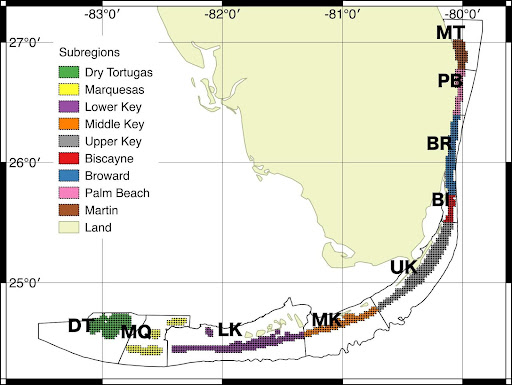A new study by scientists at the Atlantic Oceanographic and Meteorological Laboratory (AOML) and the Cooperative Institute for Marine and Atmospheric Sciences (CIMAS) provides new insights for effective restoration of the crucial reef-building coral species Acropora palmata, or Elkhorn coral.
Applying ‘Omics techniques to investigate how habitat and coral microbiomes influence ongoing restoration efforts, this research indicates Acropora palmata outplanted in shallow, low-nutrient waters and high velocity currents have a higher probability of survivorship.

A. palmata forms thickets up to 12 feet in diameter and six feet in height in shallow water that – along with Staghorn and star coral species – created over millennia the large swaths of coral reefs throughout the Caribbean today. Storm surge protection, crucial habitat for rich biodiversity and essential fisheries, millions in economic value in Florida tied to tourism alone – these corals have built the reefs that entire ecosystems and coastal communities depend on.
Today, A. palmata maintains less than 3% of its original abundance and is listed as a threatened species under the Endangered Species Act – making ongoing restoration efforts all the more crucial. Roughly 160 A. palmata genotypes – unique combinations of genetic makeup – have been identified throughout the Florida Coral Reef extending from Miami to the Florida Keys and Dry Tortugas.

The Florida Coral Reef extending Miami to Dry Tortugas
Following the 2023 marine heatwave, only 37 of those genotypes have been observed with no wild A. palmata seen south of Key Largo – a loss of roughly 77% of known genotypic diversity among A. palmata.
To effectively advance and strategize the resiliency of this key species, Stephanie Rosales, Ph.D., a lead CIMAS researcher with the lab’s ‘Omics program, and other scientists at AOML investigated how outplanted A. palmata react to oceanic conditions on a microbial and transcriptomic level – i.e. examining the gene changes within the coral’s cells and tissue.
On a cellular level, every coral has a microbiome or microbial community living within its tissue comprised of bacteria just as humans have in their mouths and digestive system. And just as we depend on these bacteria to have a healthy gut, a coral’s microbiome has been tied to its resilience and ability to endure stressful environmental conditions – fighting diseases and resistance to coral bleaching and high sea surface temperatures.
Because of this, studying how A. palmata corals respond to specific ocean conditions on the molecular level allows scientists to identify how this species reacts to environmental stressors – and ways to enhance their resilience.
With this study, scientists at AOML examined these molecular mechanisms within four A. palmata genets – coral colonies of the same species with slightly unique genetic makeup – outplanted at three reefs actively being restored by the Coral Reef Foundation (CRF) in the Florida Keys – Pickles Reef, North Dry Rocks, and Carysfort Reef.
They examined temperature, currents, depth of the reef, and inorganic dissolved nutrient levels among other environmental conditions. To investigate the microbial community or microbiome within each coral genet, they used 16S rRNA gene sequencing, a gene marker that lets you distinguish species of bacteria.
While the study found minimal correlation between the unique genetic makeup of each coral genet and the bacteria within the coral’s microbiome, habitat and environmental conditions had a clear influence on the species of bacteria observed within a coral’s microbiome – and the coral’s survivorship.
The highest survivorship of outplanted A. palmata was observed at Pickles Reef – the site with the highest velocity current – and the North Dry Rocks Reef, the shallowest depth where corals were outplanted. At Carysfort Reef a higher abundance of the bacteria Rhodobacterales within a coral’s microbiome was linked to lower survivorship of outplanted corals across the three reefs.
This key finding ties in with previous research led by Rosales suggesting Rhodobacterales is more prevalent among corals exposed to the rapidly-spreading Stony Coral Tissue Loss Disease (SCTLD) throughout the Caribbean.
Fluctuations in other conditions depending on the time of year such as higher sea surface temperatures and elevated levels of nutrients – specifically nitrate and nitrite – also led to an increase in the abundance of the pathogen Alteromonadales and the decline of an essential bacteria within the coral’s tissue.
“Outplant success is influenced by various factors, including habitat, coral microbiomes, and coral genotypes. To fully understand this intricate system, multiple techniques are needed—such as satellite data, deployed instrument data, and ‘Omics approaches— to understand coral survivorship and enhance restoration efforts.” – Stephanie Rosales, Ph.D.
Within the Florida Keys National Marine Sanctuary (FKNMS), the NOAA-wide effort Mission: Iconic Reefs launched in 2019 seeks to restore seven expert-selected reefs to self-sustaining levels by 2040.
The first phase of this project is to successfully outplant Acropora palmata among other quick-growing species to enhance the coral cover across these reefs within the first ten years from 2% to 15% – a goal that requires understanding how to maximize survivorship of these essential ecosystem-building species.
